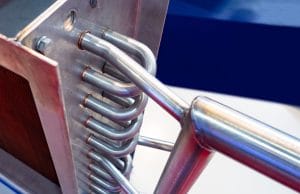 In most modern industries these days, thermal management is an important part of many different essential processes. That include everything from keeping electrical enclosures cooled so that technology can operate efficiently, to managing certain production-centric processes, such as removing heat from molds. In many cases, heat transfer technology such as heat exchangers provide the optimal solution for managing heat in a highly efficient and productive manner. The ability to meet some of the most demanding thermal management challenges with optimal efficiency, and with minimal energy and environmental footprints, have made heat exchangers and their heat transfer techniques a pillar of technological advancement.
In most modern industries these days, thermal management is an important part of many different essential processes. That include everything from keeping electrical enclosures cooled so that technology can operate efficiently, to managing certain production-centric processes, such as removing heat from molds. In many cases, heat transfer technology such as heat exchangers provide the optimal solution for managing heat in a highly efficient and productive manner. The ability to meet some of the most demanding thermal management challenges with optimal efficiency, and with minimal energy and environmental footprints, have made heat exchangers and their heat transfer techniques a pillar of technological advancement.
Heat transfer compared to other electrical cooling methods
Heat transfer methods are a highly popular electrical cooling solution these days, but they haven’t always been. Traditionally, the only viable ways for companies to implement thermal management was to rely on solutions such as air conditioners or air compressors. These solutions are designed to prevent electrical overheating by ensuring electrical enclosures stay at low, specific temperatures. To do this, they generate and circulate chilled air throughout each enclosure on a continuous basis, which is usually a highly intensive process. Instead of this, more modern solutions rely instead on methods of continuously absorbing and transferring waste heat, such as natural/forced convection, conduction, and/or phase-change cooling.
Making heat transfer a high-performance solution
The concepts that drive advanced thermal management techniques are simpler and more natural than those that utilized chilled air. However, the advanced heat exchanger solutions that utilize them do so to far greater effect than is often possible with more traditional solutions. By using eco-friendly cooling fluid and innovative unit designs, such as heat pipes and cold plates, modern heat exchangers can make heat transfer techniques an optimal solution for some of the highest performance applications. Beyond cooling electrical enclosures in large-scale manufacturing settings, this also includes creating efficient and reliable cooling solutions for smaller, more powerful, and more advanced technologies, including advanced computing and automated solutions.
How heat transfer technology is used today
With greater efficiency and reliability, today’s thermal management solutions are able to accomplish a lot more and in a much more cost-effective manner than their conventional counterparts. Heat exchangers are commonly used for solutions ranging from cooling electrical enclosures and computing technologies to specialized applications like removing heat from superheated molds, or repurposing heat for wastewater treatment processes. Designed to fit into virtually any application, heat exchangers are used for increasingly more advanced applications.
For more information about what transferring heat means for modern thermal management, call Noren Thermal Solutions in Taylor, TX, at 866-936-6736.







